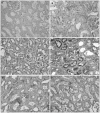Inhibiting inducible nitric oxide synthase with rutin reduces renal ischemia/reperfusion injury
- PMID: 23187035
- PMCID: PMC3569478
- DOI: 10.1503/cjs.004811
Inhibiting inducible nitric oxide synthase with rutin reduces renal ischemia/reperfusion injury
Abstract
Background: Nitric oxide (NO) seems to play an important role during renal ischemia/reperfusion (I/R) injury. We investigated whether rutin inhibits inducible nitric oxide synthase (iNOS) and reduces 3-nitrotyrosine (3-NT) formation in the kidneys of rats during I/R.
Methods: Wistar albino rats were nephrectomized unilaterally and, 2 weeks later, subjected to 45 minutes of left renal pedicle occlusion followed by 3 hours of reperfusion. We intraperitoneally administered L-N6-(1-iminoethyl)lysine (L-NIL; 3 mg/kg) for 30 minutes or rutin (1 g/kg) for 60 minutes before I/R. After reperfusion, kidney samples were taken for immunohistochemical analysis of iNOS and 3-NT. We measured plasma nitrite/nitrate and cyclic guanosine monophosphate (cGMP) to evaluate NO levels.
Results: Ischemia/reperfusion caused plasma cGMP to increase significantly. Similarly, plasma nitrite/nitrate was elevated in the I/R group compared with the control group. Histochemical staining was positive for iNOS and 3-NT in the I/R group. Pretreatment with L-NIL or rutin significantly mitigated the elevation of plasma cGMP and nitrite/nitrate. These changes in biochemical parameters were also associated with changes in immunohistochemical appearance. Pretreatment with L-NIL or rutin significantly decreased the incidence and severity of iNOS and 3-NT formation in the kidney tissues.
Conclusion: Our findings suggest that high activity of iNOS causes renal I/R injury, and that rutin exerts protective effects, probably by inhibiting iNOS.
Contexte: L’oxyde nitrique (NO) semble jouer un rôle important durant la lésion d’ischémie/reperfusion (I/R) rénale. Nous avons vérifié si la rutine inhibe l’oxyde nitrique synthase inductible (iNOS) et réduit la formation de 3-nitrotyrosine (3-NT) dans les reins de rats durant l’I/R.
Méthodes: Des rats albinos Wistar ont subi une néphrectomie unilatérale avant d’être soumis 2 semaines plus tard à une occlusion du pédicule rénal gauche d’une durée de 45 minutes, suivie de 3 heures de reperfusion. Nous avons administré de la L-N6-(1-iminoéthyl)lysine (L-NIL; 3 mg/kg) par voie intrapéritonéale pendant 30 minutes ou de la rutine (1 g/kg) pendant 60 minutes avant l’I/R. Après la reperfusion, des échantillons de tissu rénal ont été prélevés pour analyse immunohistochimique de l’iNOS et de la 3-NT. Nous avons mesuré les taux plasmatiques de nitrite/nitrate et de guanosine monophosphate cyclique (cGMP) pour évaluer les taux de NO.
Résultats: L’ischémie/reperfusion a causé une augmentation significative du cGMP plasmatique. De même, les taux de nitrite/nitrate plasmatiques ont augmenté dans le groupe soumis à l’I/R, comparativement au groupe témoin. Les épreuves de coloration histochimique ont donné des résultats positifs pour l’iNOS et la 3-NT dans le groupe soumis à l’I/R. Un prétraitement par L-NIL ou rutine a significativement atténué l’élévation des taux de cGMP plasmatique et de nitrite/nitrate. Ces changements des paramètres biochimiques ont aussi été associés à des changements de l’aspect immunohistochimique. Le prétraitement au moyen de L-NIL ou de rutine a significativement réduit l’incidence et l’ampleur de la formation d’iNOS et de 3-NT dans les tissus rénaux.
Conclusion: Nos observations donnent à penser qu’une forte activité de l’iNOS provoque la lésion I/R rénale et que la rutine confère une protection, probablement en inhibant l’iNOS.
Figures


Similar articles
-
Inhibition of inducible nitric oxide synthase reduces renal ischemia/reperfusion injury.Kidney Int. 2002 Mar;61(3):862-71. doi: 10.1046/j.1523-1755.2002.00234.x. Kidney Int. 2002. PMID: 11849439
-
Evidence for peroxynitrite formation in renal ischemia-reperfusion injury: studies with the inducible nitric oxide synthase inhibitor L-N(6)-(1-Iminoethyl)lysine.J Pharmacol Exp Ther. 2000 Oct;295(1):417-22. J Pharmacol Exp Ther. 2000. PMID: 10992009
-
GW274150, a potent and highly selective inhibitor of iNOS, reduces experimental renal ischemia/reperfusion injury.Kidney Int. 2003 Mar;63(3):853-65. doi: 10.1046/j.1523-1755.2003.00802.x. Kidney Int. 2003. PMID: 12631066
-
Nitrite in organ protection.Br J Pharmacol. 2014 Jan;171(1):1-11. doi: 10.1111/bph.12291. Br J Pharmacol. 2014. PMID: 23826831 Free PMC article. Review.
-
Modulation of oxidative neurometabolism in ischemia/reperfusion by nitrite.Free Radic Biol Med. 2022 Nov 20;193(Pt 2):779-786. doi: 10.1016/j.freeradbiomed.2022.11.021. Epub 2022 Nov 18. Free Radic Biol Med. 2022. PMID: 36403737 Review.
Cited by
-
Targeting the innate repair receptor axis via erythropoietin or pyroglutamate helix B surface peptide attenuates hemolytic-uremic syndrome in mice.Front Immunol. 2022 Sep 23;13:1010882. doi: 10.3389/fimmu.2022.1010882. eCollection 2022. Front Immunol. 2022. PMID: 36211426 Free PMC article.
-
Organ-Protective Effects of Red Wine Extract, Resveratrol, in Oxidative Stress-Mediated Reperfusion Injury.Oxid Med Cell Longev. 2015;2015:568634. doi: 10.1155/2015/568634. Epub 2015 Jun 16. Oxid Med Cell Longev. 2015. PMID: 26161238 Free PMC article. Review.
-
The protective effects of exogenous spermine on renal ischemia-reperfusion injury in rats.Transl Androl Urol. 2021 May;10(5):2051-2066. doi: 10.21037/tau-21-280. Transl Androl Urol. 2021. PMID: 34159086 Free PMC article.
-
Rutin ameliorates renal fibrosis and proteinuria in 5/6-nephrectomized rats by anti-oxidation and inhibiting activation of TGFβ1-smad signaling.Int J Clin Exp Pathol. 2015 May 1;8(5):4725-34. eCollection 2015. Int J Clin Exp Pathol. 2015. PMID: 26191162 Free PMC article.
-
Neuroprotection: Targeting Multiple Pathways by Naturally Occurring Phytochemicals.Biomedicines. 2020 Aug 12;8(8):284. doi: 10.3390/biomedicines8080284. Biomedicines. 2020. PMID: 32806490 Free PMC article. Review.
References
-
- McMichael M, Moore RM. Ischemia-reperfusion injury pathophysiology. Part I. J Vet Emerg Crit Care. 2004;14:231–41.
-
- Weinberg JM. The cell biology of ischemic renal injury. Kidney Int. 1991;39:476–500. - PubMed
-
- Waz WR, Van Liew JB, Feld LG. Nitric oxide methabolism following unilateral renal ischemia/reperfusion injury in rats. Pediatr Nephrol. 1998;12:26–9. - PubMed
Publication types
MeSH terms
Substances
LinkOut - more resources
Full Text Sources
Other Literature Sources
Research Materials
